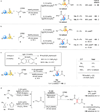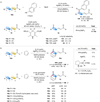Stable gold(III) catalysts by oxidative addition of a carbon-carbon bond
- PMID: 25612049
- PMCID: PMC4304402
- DOI: 10.1038/nature14104
Stable gold(III) catalysts by oxidative addition of a carbon-carbon bond
Abstract
Low-valent late transition-metal catalysis has become indispensable to chemical synthesis, but homogeneous high-valent transition-metal catalysis is underdeveloped, mainly owing to the reactivity of high-valent transition-metal complexes and the challenges associated with synthesizing them. Here we report a carbon-carbon bond cleavage at ambient conditions by a Au(i) complex that generates a stable Au(iii) cationic complex. In contrast to the well-established soft and carbophilic Au(i) catalyst, this Au(iii) complex exhibits hard, oxophilic Lewis acidity. For example, we observed catalytic activation of α,β-unsaturated aldehydes towards selective conjugate additions as well as activation of an unsaturated aldehyde-allene for a [2 + 2] cycloaddition reaction. The origin of the regioselectivity and catalytic activity was elucidated by X-ray crystallographic analysis of an isolated Au(iii)-activated cinnamaldehyde intermediate. The concepts revealed suggest a strategy for accessing high-valent transition-metal catalysis from readily available precursors.
Figures






Comment in
-
Catalysis: Gold unleashes the power of three.Nature. 2015 Jan 22;517(7535):440-1. doi: 10.1038/517440a. Nature. 2015. PMID: 25612046 No abstract available.
References
-
- Whitfield SR, Sanford MS. Reactivity of Pd(II) complexes with electrophilic chlorinating reagents: Isolation of Pd(IV) products and observation of C−Cl bond-forming reductive elimination. J. Am. Chem. Soc. 2007;129:15142–15143. - PubMed
Publication types
MeSH terms
Substances
Grants and funding
LinkOut - more resources
Full Text Sources
Other Literature Sources

